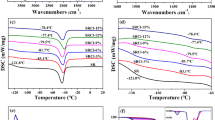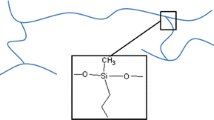Abstract
Barium titanate (BaTiO3, BT), which has a high dielectric constant was used as the filler in silicone rubber (SR) based-DE composites. The BT was added in order to achieve higher voltage-induced strains and decrease the magnitude of the applied electric fields. The morphology of SR/BT composites was observed using a scanning electron microscope. The mechanical property of the SR/BT composites, which was characterized by an equi-biaxial static test, was obtained using a bubble inflation test system. Significantly, an optimum equi-biaxial pre-stretch ratio was determined using this method in order to enhance the actuated strain achieved under an applied electric field. Concurrently, the measurements of dielectric constant and loss tangent were carried out using dielectric spectroscopy. Using the pre-stretch ratio obtained from equi-biaxial testing, the influence of BT content on the electromechanical properties of SR-based DEs was investigated. The results showed that the BT exhibited excellent dispersibility in SR matrices, but agglomerates appeared in the composites with higher filler content. An increase of dielectric constant was obtained by increasing the BT content in SR with low dielectric loss tangents below 0.035 at 0.1 Hz for all films. Also, the composite of SR/BT exhibited hyperelasticity with the minimum secant modulus at the optimised stretch ratio of 1.6. Under this specified pre-stretch ratio, a maximum actuated area strain of approximately 57 % was achieved for the film having a filler loading of 20 wt% BT. This strain corresponded to a relatively low dielectric strength of around 46 V/µm. For all the DE composites tested, a maximum electromechanical energy density (e) of 0.042 MJ/m3 and an electromechanical coupling efficiency (K 2) of 0.59 were obtained for DEs with 30 and 20 wt% BT, respectively.











Similar content being viewed by others
References
Yang D, Tian M, Dong YC, Kang HL, Gong DL, Zhang LQ (2013) A high-performance dielectric elastomer consisting of bio-based polyester elastomer and titanium dioxide powder. J Appl Phys 114(15):9. doi:10.1063/1.4824805
Madden JDW, Vandesteeg NA, Anquetil PA, Madden PGA, Takshi A, Pytel RZ, Lafontaine SR, Wieringa PA, Hunter IW (2004) Artificial muscle technology: physical principles and naval prospects. IEEE J Ocean Eng 29(3):706–728. doi:10.1109/JOE.2004.833135
Yujuan X, Zhimin D, Junwei Z, Hongtao S, Changyong S, Bai J (2009) Carbon black-BaTiO3/silicone rubber electroactive nanocomposites with large strain coefficient. In: IEEE 9th international conference on the properties and applications of dielectric materials, 2009. ICPADM 2009, 19–23 July 2009, pp 793–795. doi:10.1109/ICPADM.2009.5252166
McKay TG, Gisby TA, Anderson IA (2014) Artificial muscles harvesting sensational power using self-sensing. Proc. SPIE 9056. Electroact Polym Actuators Devices 2014:905603–905607
Pelrine R, Kornbluh R, Pei Q, Joseph J (2000) High-speed electrically actuated elastomers with strain greater than 100%. Science 287(5454):836–839. doi:10.1126/science.287.5454.836
Shankar R, Ghosh TK, Spontak RJ (2007) Dielectric elastomers as next-generation polymeric actuators. Soft Matter 3(9):1116–1129
Sheng JJ, Chen HL, Liu L, Zhang JS, Wang YQ, Jia SH (2013) Dynamic electromechanical performance of viscoelastic dielectric elastomers. J Appl Phys 114(13):8. doi:10.1063/1.4823861
Rosset S, O’Brien BM, Gisby T, Xu D, Shea HR, Anderson IA (2013) Self-sensing dielectric elastomer actuators in closed-loop operation. Smart Mater Struct 22(10):104018
Galantini F, Carpi F, Gallone G (2013) Effects of plasticization of a soft silicone for dielectric elastomer actuation. Smart Mater Struct 22(10):7. doi:10.1088/0964-1726/22/10/104020
Carpi F, Gallone G, Galantini F, De Rossi D (2008) Enhancement of the electromechanical transduction properties of a silicone elastomer by blending with a conjugated polymer. Proc SPIE 6927:692707-1–692707-11
Michel S, Zhang XQ, Wissler M, Löwe C, Kovacs G (2010) A comparison between silicone and acrylic elastomers as dielectric materials in electroactive polymer actuators. Polym Int 59(3):391–399. doi:10.1002/pi.2751
Pelrine R, Kornbluh R, Joseph J, Heydt R, Pei Q, Chiba S (2000) High-field deformation of elastomeric dielectrics for actuators. Mater Sci Eng C 11(2):89–100. doi:10.1016/S0928-4931(00)00128-4
Yang D, Zhang L, Liu H, Dong Y, Yu Y, Tian M (2012) Lead magnesium niobate-filled silicone dielectric elastomer with large actuated strain. J Appl Polym Sci 125(3):2196–2201. doi:10.1002/app.36428
Tian M, Yao Y, Liu S, Yang D, Nishi T, Zhang L, Ning N (2014) Separated-structured all-organic dielectric elastomer with large actuation strain under ultralow-voltage and high mechanical strength. J Mater Chem A. doi:10.1039/C4TA04197F
Yang D, Tian M, Kang H, Dong Y, Liu H, Yu Y, Zhang L (2012) New polyester dielectric elastomer with large actuated strain at low electric field. Mater Lett 76:229–232. doi:10.1016/j.matlet.2012.02.084
Yang D, Tian M, Li D, Wang W, Ge F, Zhang L (2013) Enhanced dielectric properties and actuated strain of elastomer composites with dopamine-induced surface functionalization. J Mater Chem A 1(39):12276–12284. doi:10.1039/C3TA12090B
Ouyang G, Wang K, Chen XY (2012) TiO2 nanoparticles modified polydimethylsiloxane with fast response time and increased dielectric constant. J Micromech Microeng 22(7):074002
Liu HL, Zhang LQ, Yang D, Yu YC, Yao L, Tian M (2013) Mechanical, dielectric, and actuated strain of silicone elastomer filled with various types of TiO2. Soft Mater 11(3):363–370
Zhang X, Wissler M, Jaehne B, Breonnimann R, Kovacs G (2004) Effects of crosslinking, prestrain, and dielectric filler on the electromechanical response of a new silicone and comparison with acrylic elastomer. In: Proceedings of the SPIE 5385, smart structures and materials 2004: electroactive polymer actuators and devices (EAPAD), vol 5385, pp 78–86
Zhang Z, Liu L, Fan J, Yu K, Liu Y, Shi L, Leng J (2008) New silicone dielectric elastomers with a high dielectric constant. In: Proceedings of the SPIE 6926, modeling, signal processing, and control for smart structures 2008, 6926, pp 692610–692618
Qiang J, Chen H, Li B (2012) Experimental study on the dielectric properties of polyacrylate dielectric elastomer. Smart Mater Struct 21(2):025006
Koh SJA, Li T, Zhou J, Zhao X, Hong W, Zhu J, Suo Z (2011) Mechanisms of large actuation strain in dielectric elastomers. J Polym Sci Part B 49(7):504–515. doi:10.1002/polb.22223
Tianhu H, Guanghong M, Cheng C (2011) The effect of prestretch on the performance of a dielectric elastomer membrane. In: 2011 international conference on remote sensing, environment and transportation engineering (RSETE), 24–26 June 2011, pp 6463–6467. doi:10.1109/RSETE.2011.5965837
Makuuchi K, Cheng S (2012) Radiation processing of polymer materials and its industrial applications. Wiley, Hoboken
Arora S, Ghosh T, Muth J (2007) Dielectric elastomer based prototype fiber actuators. Sens Actuators A 136(1):321–328. doi:10.1016/j.sna.2006.10.044
Zhao X, Wang Q (2014) Harnessing large deformation and instabilities of soft dielectrics: theory, experiment, and application. Appl Phys Rev 1(2):021304. doi:10.1063/1.4871696
Suo Z (2010) Theory of dielectric elastomers. Acta Mech Solida Sin 23(6):549–578
Lu T, Huang J, Jordi C, Kovacs G, Huang R, Clarke DR, Suo Z (2012) Dielectric elastomer actuators under equal-biaxial forces, uniaxial forces, and uniaxial constraint of stiff fibers. Soft Matter 8(22):6167–6173. doi:10.1039/C2SM25692D
Lei W, Wang R, Yang D, Hou G, Zhou X, Qiao H, Wang W, Tian M, Zhang L (2015) Design and preparation of bio-based dielectric elastomer with polar and plasticized side chains. RSC Adv 5(59):47429–47438
Zhou Y, Jerrams S, Betts A, Chen L (2014) Fatigue life prediction of magnetorheological elastomers subjected to dynamic equi-biaxial cyclic loading. Mater Chem Phys 146(3):487–492. doi:10.1016/j.matchemphys.2014.03.059
Jerrams S, Murphy N, Hanley J (2012) The significance of equi-biaxial bubble inflation in determining elastomeric fatigue properties. In: Boczkowska A (ed) Elastomers. INTECH Open Access Publisher, Rijeka
Zhou Y, Jerrams S, Chen L (2013) Multi-axial fatigue in magnetorheological elastomers using bubble inflation. Mater Des 50:68–71. doi:10.1016/j.matdes.2013.02.071
Kulkarni AJ, Zhou M, Ke FJ (2005) Orientation and size dependence of the elastic properties of zinc oxide nanobelts. Nanotechnology 16(12):2749
Dimopoulos E, Trintis I, Munk-Nielsen S (2013) Comparison of the dielectric electroactive polymer generator energy harvesting cycles. Proc SPIE 8687:86870O-1--86870O-13
Takala M (2010) Electrical insulation materials towards nanodielectrics. Tampereen teknillinen yliopisto Julkaisu-Tampere University of Technology Publication, 928
Sharma M, Madras G, Bose S (2014) Process induced electroactive [small beta]-polymorph in PVDF: effect on dielectric and ferroelectric properties. Phys Chem Chem Phys 16(28):14792–14799. doi:10.1039/C4CP01004C
Gallot-Lavallée O (2013) Dielectric Materials and Electrostatics. Wiley, Grenoble
Luo B, Wang X, Wang Y, Li L (2014) Fabrication, characterization, properties and theoretical analysis of ceramic/PVDF composite flexible films with high dielectric constant and low dielectric loss. J Mater Chem A 2(2):510–519. doi:10.1039/C3TA14107A
Gallone G, Carpi F, De Rossi D, Levita G, Marchetti A (2007) Dielectric constant enhancement in a silicone elastomer filled with lead magnesium niobate–lead titanate. Mater Sci Eng C 27(1):110–116. doi:10.1016/j.msec.2006.03.003
Carpi F, Rossi DD (2005) Improvement of electromechanical actuating performances of a silicone dielectric elastomer by dispersion of titanium dioxide powder. IEEE Trans Dielectr Electr Insul 12(4):835–843. doi:10.1109/TDEI.2005.1511110
Das SK, Choi SU, Yu W, Pradeep T (2007) Nanofluids: science and technology. Wiley, Hoboken
Namitha LK, Chameswary J, Ananthakumar S, Sebastian MT (2013) Effect of micro- and nano-fillers on the properties of silicone rubber-alumina flexible microwave substrate. Ceram Int 39(6):7077–7087. doi:10.1016/j.ceramint.2013.02.047
Yang R, Wong CP, Qu J, Marinis T Effective dielectric constant prediction of polymer-ceramic composite based on self-consistent theory. In: proceedings of the 50th electronic components & technology conference, 2000, pp 615–618. doi:10.1109/ECTC.2000.853222
Okano T (1993) Molecular design of temperature-responsive polymers as intelligent materials. In: Dušek K (ed) Responsive Gels: Volume Transitions II. Advances in Polymer Science, vol 110. Springer, Berlin Heidelberg, pp 179–197. doi:10.1007/BFb0021133
Poon YM, Shin FG (2004) A simple explicit formula for the effective dielectric constant of binary 0-3 composites. J Mater Sci 39(4):1277–1281. doi:10.1023/B:JMSC.0000013886.21054.e4
Araújo MC, Costa CM, Lanceros-Méndez S (2014) Evaluation of dielectric models for ceramic/polymer composites: effect of filler size and concentration. J Non-Cryst Solids 387:6–15. doi:10.1016/j.jnoncrysol.2013.12.005
Dissado LA, Fothergill JC (1992) Electrical degradation and breakdown in polymers. vol 9. IET,
O’Dwyer J (1982) Breakdown in solid dielectrics. IEEE Trans Electr Insul 6:484–487
Acknowledgements
The authors gratefully acknowledge the support provided by the DIT Fiosraigh Dean of Graduate Students Award.
Author information
Authors and Affiliations
Corresponding author
Rights and permissions
About this article
Cite this article
Jiang, L., Betts, A., Kennedy, D. et al. The fabrication of dielectric elastomers from silicone rubber and barium titanate: employing equi-biaxial pre-stretch to achieve large deformations. J Mater Sci 50, 7930–7938 (2015). https://doi.org/10.1007/s10853-015-9357-6
Received:
Accepted:
Published:
Issue Date:
DOI: https://doi.org/10.1007/s10853-015-9357-6




